| Article ID | Journal | Published Year | Pages | File Type |
|---|---|---|---|---|
| 4681708 | Geoscience Frontiers | 2013 | 11 Pages |
The Panzhihua intrusion in southwest China is part of the Emeishan large igneous province and host of a large Fe-Ti-V ore deposit. In previous interpretations it was considered to be a layered, differentiated sill with the ore deposits at its base. New structural and petrological data suggest instead that the intrusion has an open S-shape, with two near-concordant segments joined by a discordant dyke-like segment. During emplacement of the main intrusion, multiple generations of mafic dykes invaded carbonate wall rocks, producing a large contact aureole. In the central segment, magmatic layering is oriented oblique to the walls of the intrusion. This layering cannot have formed by crystal settling or in-situ growth on the floor of the intrusion; instead we propose that it resulted from inward solidification of multiple, individually operating, convection cells. Ore formation was triggered by interaction of magma with carbonate wall rocks.
Graphical abstractFigure optionsDownload full-size imageDownload as PowerPoint slideHighlights► Panzhihua Permian intrusion hosts a large Fe-Ti-V deposit. ► Ore deposit at the base of the discordant central portion. ► Ore formation through interaction between magma and carbonate wall rocks.
